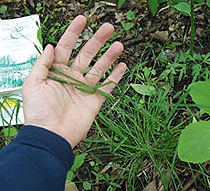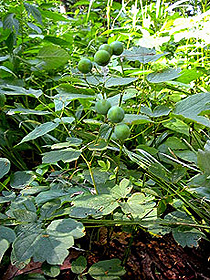Fermilab ecologist discovers two rare plants
 |
| Fermilab contract restoration ecologist Ryan Campbell holds a sprig of woodland bluegrass, Poa sylvestris, a recently discovered rare plant species at Fermilab. Image courtesy of Ryan Campbell. |
Tucked out of sight and sheltered in the woods near Fermilab's main entrance, something extraordinary is happening. A tender little plant is bearing fruit and will soon go to seed in a brilliant burst of iridescent blue.
The blue cohosh, one of two plant species identified for the first time at Fermilab this spring, may look fragile, but its presence marks a victory for woodland restoration.
Consulting restoration ecologist Ryan Campbell identified the blue cohosh, Caulophylum thalictoides, and woodland bluegrass, Poa sylvestris, while surveying Fermilab woodlands in May. These native plants are uncommon in Chicagoland, making them valuable to conservation efforts.
"Those plants wouldn't be here without a whole team effort," Campbell said. "They are here because of the work done at Fermilab and through the entire Chicago area's conservation community."
As Campbell noted on the Fermilab Natural Areas blog, the cohosh was likely brought onsite through a seed exchange between Fermilab and a local county forest preserve to increase biodiversity.
The woodland bluegrass is more mysterious. Difficult to spot, this plant may have been onsite for some time but was overlooked or mistaken for a common grassy cousin.
"Whenever we find a new plant, it's like finding a new piece in this big puzzle," said Fermilab Roads and Grounds' Bob Lootens. "We're not going to find all of the pieces, but every new piece is important in restoring what we once had."
The discovery of thriving native plants indicates the success of restoration efforts. Woodland and prairie burnings have been instrumental in Fermilab's restoration, removing invasive species and encouraging native plants to reclaim their natural niche.
"What we're doing is working and clearly needs to continue," Campbell said. "This is good for Fermilab and good for the region. Five years from now, you never know what plant we'll find next."
-- Daisy Yuhas
 |
| The uncommon and newly discovered blue cohosh, Caulophylum thalictoides, will soon be bearing bright blue seeds. |
|